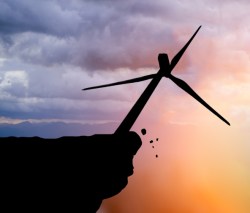Midwest Energy News profiles the push to build the Wildcat wind farm in Elwood, Ind.

Timber.
[A] major construction project is under way on these 1,700 acres of central Indiana farmland. The goal: build more than 100 wind turbines, each 30 stories tall, and get them running by midnight on December 31 … Access roads have to be built into farm fields; foundations have to be excavated. To hold up a single turbine it takes 400 cubic yards of concrete and 36 tons of rebar—meaning the entire wind farm will use enough concrete to pour a 3-foot-wide, 4-inch-thick sidewalk from central Indiana to St. Louis. Each of the five sections of each 300-foot tower is transported to the site on a semi, then stacked in place with the sort of crane used to build skyscrapers.
The nacelle—a fiberglass-encased box with more than 70 tons of equipment inside, including the electricity-generating components of the turbine—is placed atop the tower. Then each of the 160-foot blades must be mounted on top of the tower.
All this work means jobs, and lots of them, [construction manager Mike] Behringer said. One hundred seventy people, including iron workers, crane operators, laborers, and linemen are all employed building the first phase of the Wildcat wind farm, which will have the capacity to produce 200 MW of energy.
Why that Dec. 31 deadline? On the last day of the year, the production tax credit (PTC) for wind power expires, eradicating a significant support for the growing industry. By some estimates, the expiration of the PTC could cost nearly 40,000 jobs — as Midwest Energy News notes:
White Construction is racing the clock to get all 125 turbines built by then so the project’s developer, Chicago-based E.ON Climate and Renewables, can qualify the turbines for the 2.2 cents tax credit for every kWh of electricity produced.
Behringer said he’s “very confident” that White will meet that deadline. But the fate of the second, third, and fourth phases of the planned project, with more than 550 MW of additional capacity and more than 200 additional turbines, rises and falls with the wind production tax credit.
Unless the tax credit is renewed, Behringer said, “there are no projects and no jobs from the beginning of the year on out.”
The only way the PTC can be preserved is through action on Capitol Hill. There was a positive step toward that end last month when a bipartisan package of tax breaks, including the PTC extension, cleared a Senate subcommittee. But Senate Majority Leader Harry Reid (D-Nev.) has not scheduled the bill for a vote — with only days remaining before the Senate adjourns. Politico reports:
The package was approved by the Senate Finance Committee in August and Chairman Max Baucus hoped to have it on the floor before Congress headed home for the elections. Baucus and Utah Sen. Orrin Hatch, the panel’s top Republican, cast the August agreement as a small step toward the larger job of overhauling the tax code, which both parties say is a priority next year.
But with the Senate possibly adjourning as soon as next week, time is the biggest hurdle to clearing a bill through the chamber. …
Several Senate Republicans don’t support the bill and five of the 11 GOP members on the Senate Finance Committee voted against the package in August saying they were concerned with the its cost.
And House Republicans say they don’t plan to take up the tax package until after the election. In two weeks, the House and Senate will both be on recess, members back in their districts, many of them campaigning to save their jobs. Out in a field in Indiana, Mike Behringer and the rest of his crew will be hustling to finish one last wind farm — before thousands in their industry lose their jobs entirely.



